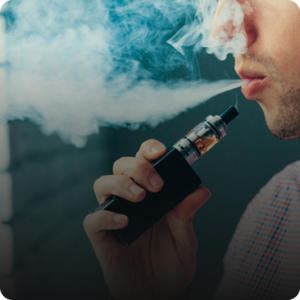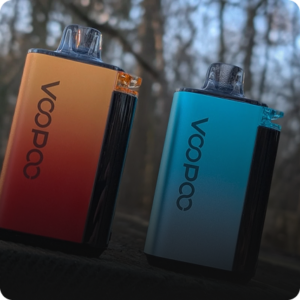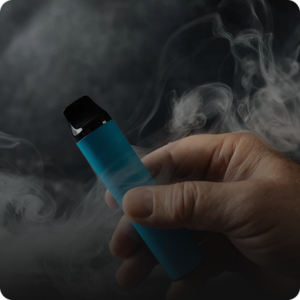Vaping has become a familiar sight. From busy streets to cozy living rooms, vapor clouds are part of our modern landscape. As the vaping community grows, so do questions about its impact on others.
Is that lingering vapor harmful? Should non-vapers be concerned?
As someone deeply immersed in vaping culture, I’ve encountered these concerns time and again. Let’s clear the air and examine the facts.
Current evidence suggests minimal risk. But the jury’s still out on long-term effects. Let’s dive deeper.
Secondhand vapor isn’t smoke. It’s an aerosol. Exhaled by e-cigarette users, it lingers briefly in the air.
Key differences from cigarette smoke:
Vapor contains fewer harmful chemicals than smoke. But it’s not just water vapor either.
When someone vapes, their device heats e-liquid. This creates an aerosol. The user inhales it, then exhales. What’s left is secondhand vapor.
Unlike cigarettes, e-cigarettes don’t produce sidestream emissions. There’s no constant stream of vapor from the device itself. This means less overall exposure for bystanders.

Let’s break it down:
Component
In Inhaled Vapor
In Exhaled Vapor
Potential Concern
Surprising fact: 93.8% of inhaled nicotine stays with the vaper. A University of California-San Francisco study confirmed this 1. This means the nicotine content in secondhand vapor is very low.
The base of most e-liquids is propylene glycol (PG) and vegetable glycerin (VG). These are generally recognized as safe for ingestion. However, long-term effects of inhalation are still being studied.
Flavorings are a wild card. Some are food-grade and considered safe to eat. But inhaling them? That’s a different story. More research is needed.
As for harmful chemicals, they’re present but in tiny amounts. Formaldehyde, acetaldehyde, and acrolein have been detected. But levels are much lower than in cigarette smoke.
Worried about indoor air? Don’t be.
A UC San Diego study of 193 homes found something interesting. Smoking affected air quality. So did cooking and burning candles. Vaping? No measurable effect 2.
The study used sensitive air quality monitors. They picked up particles from various activities. But vaping didn’t register. This suggests its impact on indoor air quality is minimal.
Even vape shops show minimal impact. A NIOSH study found chemical levels below occupational limits. This was true even with 13 customers vaping throughout the day 3.
Think about that. In a space where vaping is constant, levels still didn’t exceed safety standards. For the average person exposed to occasional secondhand vapor, risks appear to be very low.
Worried about indoor air? Don’t be.
Public Health England’s verdict? Clear. “No identified health risks of passive vaping to bystanders” 4. This comes from their comprehensive 2018 evidence review.
Dr. Igor Burstyn, a toxicology expert, agrees. He estimates bystander exposure to be “orders of magnitude” below safety limits 5. His 2014 study reviewed over 9,000 observations of e-cigarette liquid and vapor content.
Both these sources suggest secondhand vapor poses little risk. But they also call for more research. Especially on long-term effects.
The Royal College of Physicians has weighed in too. They state that “there is, so far, no evidence that exposure to the aerosol produced by e-cigarettes is likely to cause significant harm to bystanders” 6.
Research continues. Our understanding may evolve. But current evidence is reassuring.

Secondhand vapor isn’t smoke. It’s an aerosol. Exhaled by e-cigarette users, it lingers briefly in the air.
Want to reduce potential risks further?
Nicotine deserves special mention. It’s the primary reason many people vape. But how dangerous is it in secondhand vapor?
Nicotine deserves special mention. It’s the primary reason many people vape. But how dangerous is it in secondhand vapor?
Studies show nicotine levels in secondhand vapor are very low. Remember that 93.8% retention rate? It means very little escapes into the air.
Moreover, nicotine absorbed from secondhand vapor appears to be negligible. A 2017 study found no increase in nicotine levels in non-smokers exposed to secondhand vapor in a real-world setting 7.
This doesn’t mean nicotine exposure is risk-free. But in the context of secondhand vapor, it doesn’t seem to be a major concern.

It’s natural to compare secondhand vapor to secondhand smoke. After all, both come from inhaled products. But the differences are stark.
Secondhand smoke contains over 7,000 chemicals. Hundreds are toxic. At least 69 can cause cancer. It’s a major health risk, linked to heart disease, lung cancer, and other serious conditions.
Secondhand vapor, in contrast, contains far fewer chemicals. Those present are generally in much lower concentrations. While not completely risk-free, it’s a world apart from secondhand smoke.
This doesn’t mean we should be complacent. But it does put the risks in perspective.
Secondhand vapor appears safe. Studies show minimal risk. But research continues.
Vape responsibly. Stay informed. Respect others.
The vaping story is still unfolding. Be part of a positive chapter.
Want to reduce potential risks further?
As vapers, we have a responsibility. To ourselves, to those around us, and to the future of vaping. By staying informed and acting responsibly, we can help ensure that vaping remains a safer alternative to smoking.
Goniewicz, M.L., et al. (2014). Levels of selected carcinogens and toxicants in vapour from electronic cigarettes. Tobacco Control, 23(2), 133-139. https://pubmed.ncbi.nlm.nih.gov/23467656/
2
Klepeis, N.E., et al. (2017). Fine particles in homes of predominantly low-income families with children and smokers: Key physical and behavioral determinants to inform indoor-air-quality interventions. PLoS One, 12(5), e0177718. https://www.ncbi.nlm.nih.gov/pmc/articles/PMC5435241/
3
NIOSH. (2017). Evaluation of Chemical Exposures at a Vape Shop. Health Hazard Evaluation Report 2015-0107-3279. https://www.cdc.gov/niosh/hhe/reports/pdfs/2015-0107-3279.pdf
4
McNeill, A., et al. (2018). Evidence review of e-cigarettes and heated tobacco products 2018. A report commissioned by Public Health England. https://assets.publishing.service.gov.uk/media/5a981c6740f0b67aa27253cc/Evidence_review_of_e-cigarettes_and_heated_tobacco_products_2018.pdf
5
Burstyn, I. (2014). Peering through the mist: systematic review of what the chemistry of contaminants in electronic cigarettes tells us about health risks. BMC Public Health, 14, 18. https://bmcpublichealth.biomedcentral.com/articles/10.1186/1471-2458-14-18
6
Royal College of Physicians. (2016). Nicotine without smoke: Tobacco harm reduction. London: RCP. https://www.rcp.ac.uk/media/xcfal4ed/nicotine-without-smoke_0.pdf
7
Johnson, J.M., et al. (2017). A biomonitoring assessment of secondhand exposures to electronic cigarette emissions. International Journal of Hygiene and Environmental Health, 220(2), 253-257. https://www.ncbi.nlm.nih.gov/pmc/articles/PMC6938228/
Danny Blanton, a seasoned writer with a decade of industry experience, offers expert reviews on vaping products and cannabis topics, ensuring our readers receive accurate, up-to-date, and valuable insights.



















Product In-Stock: InStock

Product In-Stock: InStock

Product In-Stock: InStock

Product In-Stock: InStock

Product In-Stock: InStock

Product In-Stock: InStock
















Get special offers and find out what’s new in the store. Sign up for the EV newsletter.